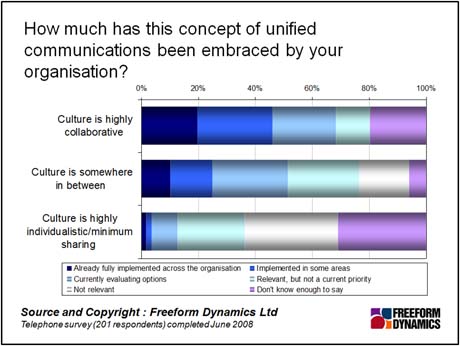Although the Unified Communications (UC) propositions from the key vendors in the market encompass a lot of very clever functionality, the market is dragging its heels in embracing UC in all its glory. This has been evidenced by research that Freeform Dynamics has carried out in association with Macehiter Ward-Dutton, with large enterprises in the European market. The results of this research showed that both IPT and UC implementations are at a relatively low level, and in many cases, are only partial implementations. Furthermore, the degree to which an enterprise has integrated, or plans to integrate UC shows a strong correlation to the management culture of that enterprise, in terms of how collaborative it is. The chart below shows how much enterprises are embracing the concept of UC. As is evident, the more collaborative the management culture, the more likely the organisation is to embrace UC.

This view was further corroborated when I met with BT recently, which believes that a major UC driver is collaboration. Furthermore, our collaborative culture is being strongly driven from the consumer side – witness the phenomenal growth in collaborative applications such as Skype, MySpace and Facebook. What has made these applications particularly successful is that they are very user friendly, intuitive tools that are free and of course, they work pretty much first time and all the time. Compare and contrast this with applications in the corporate environment. And here lies part of the dilemma.
Essentially, BT believes that the key to real growth in the UC market boils down to the user interface (UI), with the argument over which vendor to choose becoming largely irrelevant. There is probably a lot of truth in this. Enterprises are genuinely very confused by the concept of UC, and that this confusion is further compounded by the various ‘mine is better than yours’ messages of the vendors.
Even if a sound business case for UC were to fall out of the sky, then, for the majority of enterprises, their infrastructure simply cannot cope, with networks often not optimised for ongoing corporate communications, let alone real-time communications. The key, therefore, is to focus on optimization of the network so that it is essentially UC ready. But alongside this, ensure that the communications capability is embedded within the UI, and the transition to UC is a much smoother, more gradual one that simply just happens.
BT’s approach to the UC market is a very different one to that of the vendors, and is certainly very interesting. A lot of investment has gone into UC for it not to happen, and perhaps BT’s approach will provide the impetus that the market needs. Watch this space, I think.
Through our research and insights, we help bridge the gap between technology buyers and sellers.





Have You Read This?
From Barcode Scanning to Smart Data Capture
Beyond the Barcode: Smart Data Capture
The Evolving Role of Converged Infrastructure in Modern IT
Evaluating the Potential of Hyper-Converged Storage
Kubernetes as an enterprise multi-cloud enabler
A CX perspective on the Contact Centre
Automation of SAP Master Data Management
Tackling the software skills crunch